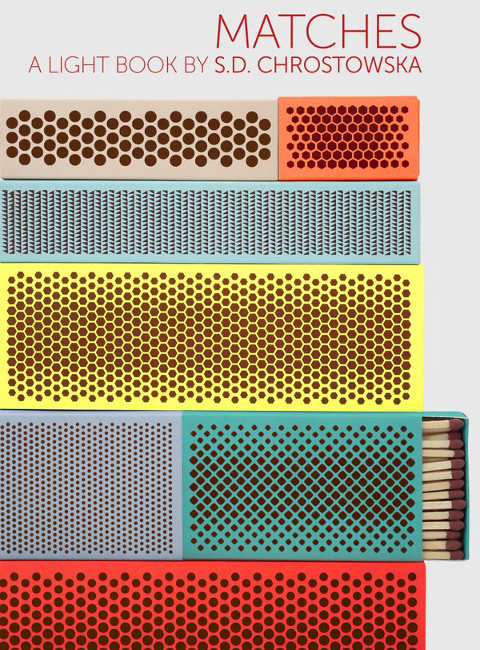MATCHES: A Light Book
S.D. Chrostowska
punctum books, 2015
538 pages (OPEN-ACCESS e-book and $25.00 [€23.00/£20.00] in paper)
ISBN-13: 978-0692540732
x
Art / Barbarism
Unfortunately, I have a bad feeling that a huge and horrible crime happened, and the masterpieces were destroyed. If so, it would be a barbarian crime against humanity. — Ernest Oberländer-Târnoveanu, director of Romania’s National History Museum, on the incineration of seven masterpieces stolen in 2012 from the Rotterdam Kunsthal
A mother’s love burns brightest when the fuel is artifice, plastic slippers, and firewood. Art’s demise revealed the truth and power of the human heart. Veritas, victoria, vita!
The museum, the village, the abandoned house, the churchyard, finally the stove. Ash. Between the theft, the son’s arrest, the mother’s actions, and the art world itself (fearing the worst), the works were everything: a fortune, incriminating evidence, an irreparable loss. To the rest of us it was a crying shame. Before the lab’s findings sank in, the works were missed, their worth contained by the smouldering hope of their recovery, the story still too bizarre to be believed (especially after the mother’s retraction of the crucial part of it). After they were announced, the works became priceless, and their immolation, indefensible, beyond the pale. Here there is no why. We are survivors, bearing the burden of incomprehension. Incomprehension not of the human spirit, for the mother’s act was as mindless as the can of worms it opened.
Nor was it a crucible of love — that mother was no art lover! It involved no test, no inner conflict of values, one love against another fighting in a breast, with a mother’s love finally getting the better of the universal love of beauty.
Burn the evidence! was the obvious thing to do. Not: I must sacrifice the Art! (We would prefer she turn in the works along with the son, but what mother would do that? — it is as unfeasible now as it was in biblical times.) A simpleton cannot be demonic. There was no question of zeal, of enthusiasm, of erotic arousal: Burn, Picasso! Burn, Matisse! And yet it used to be witches who stoked fire only to perish by it in those barbaric times. The innocence of the paintings, the Eastern European location, the poverty, illiteracy perhaps — all this makes for a credible latter-day hex.
And that is why, in a rush of blood to the head, we might blurt out “Crime against humanity!” The well-worn phrase — where the “crime” in question is nothing less than intentional degradation of human beings perpetrated on a large scale — seems hyperbolic in the new context, even if in the heat of indignation (to which destruction by fire certainly added fuel), we refuse to see it as just a metaphor.
The leap from humans to the human is easier the more the art of the recent past, when there were still masters worth mentioning, is sanctified as the expression of the human spirit, the quiddity of our dignity that protects us, like a magic circle, against all barbarism.
Art appreciation is an order of magnitude greater than art’s invaluability. The inestimable worth of art — of man — in our time requires the language of genocide to do justice to it. It is no “mere rhetoric,” but an unedited lament for humanity.
If, then, it strikes some of us as preposterous to call an art heist a “crime against humanity,” it must be because we do not value art as an extension of human dignity. Is it because art has always accompanied barbarity, as its counterpoint? Our whole history is constructed on denying that we cannot have the one without the other, even if art was born among the barbarians. The twisted story of the burglary, the brutalization of these works, brings this twisted history, begun in prehistory, to a head. Acts we would consider barbarous now, or that we will consider barbarous in the future, were perpetrated by those we now consider to have been the first artists, even the first “moderns.” The stature of barbarity keeps step with that of art. The more invaluable art becomes, the less we can appreciate it. The more invaluable individual life becomes, the less we can appreciate it.
We might not know it, but such wisdom speaks through our condemnation of Oberländer-Târnoveanu’s hyperbole. To accept it would mean convincing ourselves that a mother’s love counts for nothing, that it is worthless. You cannot make the willful destruction of high art level with the annihilation of people without elevating at least one mother’s love to barbarism.
Even if the crude destruction of these Magnificent Seven really was atrocious, some more refined method would have been easier to swallow. Its artfulness would mitigate its vulgarity. That is why we hope she did not burn them but, as unlikely as that is, deceived the analysts. Perhaps then her act would qualify as art, a performance without spectacle, with an audience to come. It’s been said — I know the man who said it — that “Barbarity is one of the signs in which one recognizes renaissances of the spirit.”{{1}}[[1]]Miguel Abensour, “L’histoire de l’utopie et la destin de sa critique,” Textures 8–9 (1974): 64, my trans.[[1]]
§
Under Attack
The avant-garde artist was born of the image-breaker: the “icons” he broke belonged to his predecessors and rivals. In truth, however, they were the icons by which he lived his life and with which the art of his time was in agreement. His target, then, must not have been the artistic tradition, at least not directly; it was, rather, the reality sanctioning only images that flatter it — images that, while innocent, were thoroughly in the pay of wealthy patrons, who surrounded themselves with them as with mirrors. Naturally, the control of images made them structurally incapable of fulfilling art’s modern mission — to challenge, to unsettle, to open up. Only from the position of exteriority claimed by modern art can the false beauties of the life of privilege, of the dream life of power, be violated. Modernity’s artistic frontier is inward, advancing towards, not away from, the pieties and powers — political, economic, theological — with which even the old masters were in conformity. The image broken by the modern iconoclast, the icon reduced to shards and rags, is, in short, the spurious coherent whole, with the “art world” nestled in it.
§
Art, Alienation, Extinction
There is a received and much-cherished idea that creativity cannot be alienating. Alienation befalls the exploited, their labour as mindless as it is repetitive, whereas creative work, where it is not enabled by higher economic standing, the prerogative of leisure, is mythologized as an escape into pleasure (even with the risk of madness or early death). Artists, of course, do collaborate, make, market, and sell their stuff, and the identity of the artist is perfectly compatible with that of the precarious worker or capitalist. But the neoliberalization of art is seen as incomplete as long as art is civilized by the triumph of form over content; form acts as a bulwark against the neoliberal civilization, whose watchword is content extraction. Capitalism keeps pace by producing the tools needed to extract content from form, funding art’s nonconformism. The creation of educational and other institutions that teach both art and its exploitation, as well as the rewards dangled before artists who defend art’s bulwark, keep up demand for aesthetic product. At a time when everything is being turned into a resource, art can still set the terms of its own use.
A reboot of art’s political-interventionist ferment in the 1960s and ’70s would offer no resistance to neoliberalism’s encroachment. The identity of the artist has since become much purer, much more abstract and — dare we say? — superfluous than in those days. All is well as long as it’s understood as just an identity or mask, and moreover, one among several others in competition or cooperation with it. Now that the “Creative Class” has been ideologically defined as vital for urban economies, the “creative subject,” a.k.a. artist, risks not alienation but isolation. With lived experience becoming art’s final court, whoever identifies with art to the exclusion of other roles — whoever lives and breathes art and otherwise lives not — must die of loneliness as one of the last surviving members of a species too old to reproduce.
§
Down and Dirty
If art really needs a clean slate, then life must have the opposite. But could we appreciate such art from such a life?
§
Scenes of Abduction
In the story of the rape of Hippodamia, a Lapith woman is saved from the clutches of drunken Centaurs, guests at her wedding feast. The oft-treated motif, allegorized as the struggle between bestiality or barbarism and humanity or civilization, ends quite clearly in the latter’s triumph. As with other erotic subjects, mythical or legendary scenes of abduction, depictions of lecherous violence and abuse, were long bound to a higher, moral purpose, while heroism and procreation as pretexts for titillation were deemed unworthy of art.
The sublimation called art is still aligned with nobility and morality. Art does not just represent — and that in two senses, of showing and standing for — the struggle against barbarism; it functions as a talisman. The choice and proper framing of scenes of this struggle fulfill art’s civilizing mission, contributing head-on to the mastery over monstrosity, ugliness, and evil looming large. The mission’s goal was to impress upon our minds the seriousness and high stakes of the fight for, in this case, sexual entitlement. The artist wanted us to know, none too subtly, that he had done his part.
The “Manichean” framework, which demands explicitness, comes at a cost to art, which is accused of speaking from both sides of its mouth. On the one hand, bringing sexuality to the surface and manipulating it make artists complicit in subduing anarchic forces — including the eternal two-way traffic between the normal and the freakish, the familiar and the foreign. Art renounces pornography less for its content and effect than for subordinating such forces to quantitative self-regulation. On the other hand, as soon as the image becomes explicit, art falls under suspicion by priests and secular moralists of colluding with base desire. It is watched more closely and interpreted less charitably; exposed, it presents an easy target for yesterday’s orthodoxies. Doubt in its ability to quell insurgent passions makes conspicuous not what is obvious to us — art’s neutrality — but its barely hidden “barbarism.”
The long-term consequences of this double bind are still with us: even now, freed from moral service, sexuality in art is dismissed as gimmickry, gratuitous provocation. Its aesthetic value is dubious; it is still too caught up in proving it has one. Its appearance is stiff, unnatural, in a word, unfree — and this in spite of the space given to it, having spread from canvas to celluloid, where it is occasionally even unsimulated. Its real, scrambled message is only intelligible to those who reject moralism of any kind and recognize art’s long struggle for a pagan origin.
Where it does not eradicate unruliness, censorship inspires encryption. In this hostage hermeneutic, sexually charged representations like that of Hippodamia’s rape, as they recur from the Renaissance on, are coded signs of distress. Rather than hailing the victory of the good through art, hence of “good” art, they signal art’s capture by “goodness.”
§
Coming Clean
If life really is a blank slate, then art must be the opposite.
—S. D. Chrostowska
x
S.D. Chrostowska is the author of Permission (Dalkey Archive Press, 2013).
x
x


This is one monstrously intelligent, captivating book. Or a monstrously captivating, intelligent book. And I mean that in the best way possible.